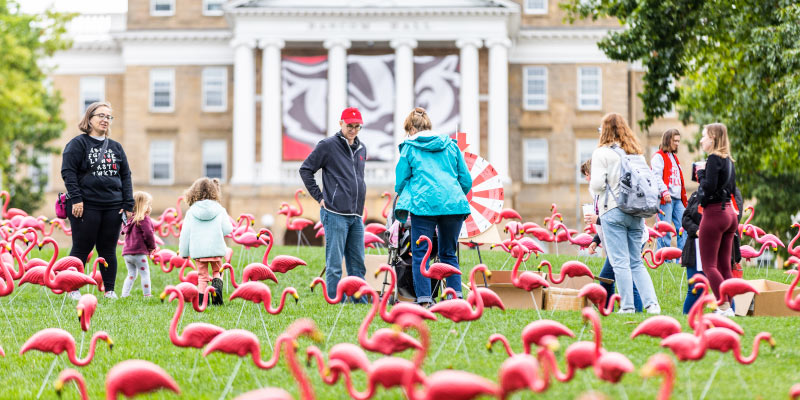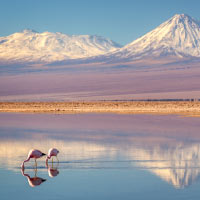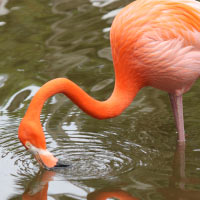

On a fall day on campus, you might see sandhill cranes wading in the Lakeshore Nature Preserve, house sparrows cleaning up by the food carts on Library Mall, and if you’re lucky, maybe even a pair of canvasbacks floating along the Lake Mendota shoreline. And if it’s Homecoming week, you’re probably turning your binoculars to Bascom for the annual flamingo migration … lawn flamingos, that is. Plastic or feathers aside, we consulted avian expert and Nelson Institute faculty affiliate Anna Pidgeon, who shares some of her favorite flamingo facts to celebrate this year’s Fill the Hill campaign.
- There are six species of flamingos: the Chilean, James’s, and Andean flamingos of South America; the American flamingo, which spans the islands and shorelines of the Caribbean, northern coasts of South America, and the Galapagos; and the greater and lesser flamingos which inhabit parts of Africa, Western Asia, and southern Europe.
 Few icons are more synonymous with tropical paradise than the flamingo, the majority of James’s and Andean flamingos inhabit lakes high in the Andes Mountains.
Few icons are more synonymous with tropical paradise than the flamingo, the majority of James’s and Andean flamingos inhabit lakes high in the Andes Mountains.
- Flamingos prefer salty lakes and lagoons. When bodies of water are too high in saline for fish to survive, flamingos get the plankton all to themselves.
 Phenomenal foragers, flamingos have adapted to use their beaks as a sieve. With their heads upside-down underwater, they strain their food by pushing mud and water out of the thin membranes on the sides of their bills.
Phenomenal foragers, flamingos have adapted to use their beaks as a sieve. With their heads upside-down underwater, they strain their food by pushing mud and water out of the thin membranes on the sides of their bills. - While no flamingo species are listed as threatened or endangered, several — including the Andean flamingo — are seeing declining populations due to habitat degradation from human disturbance, hunting pressures, and more. The American flamingo, however, is seeing an increasing population.
- The American flamingo is typically found in lagoons and salt pans in the Caribbean, South America, and the Galapagos Islands, but in 2023, a flock of five were spotted right here in Wisconsin. Ten other states recorded atypical flamingo sightings around the same time — likely in response to Hurricane Idalia, which hit Florida that August.
Want even more ’mingo content? Head to our social media accounts (@nelsoninstitute) to follow along as we celebrate Fill the Hill. Or, head right to uwflamingos.com/nelson to participate!
 Few icons are more synonymous with
Few icons are more synonymous with  Phenomenal foragers, flamingos have adapted to use their beaks as a sieve. With their heads upside-down underwater, they strain their food by pushing mud and water out of the thin membranes on the sides of their bills.
Phenomenal foragers, flamingos have adapted to use their beaks as a sieve. With their heads upside-down underwater, they strain their food by pushing mud and water out of the thin membranes on the sides of their bills.